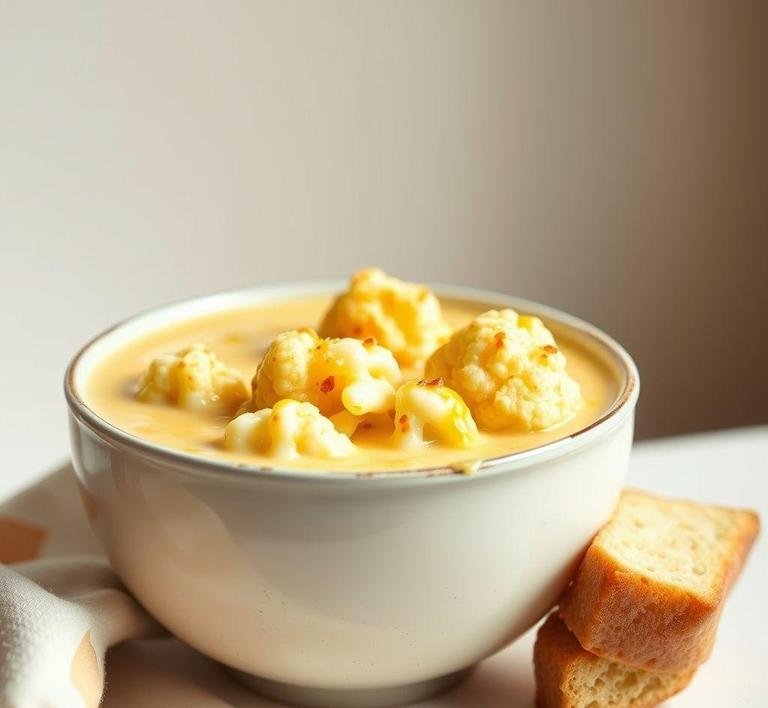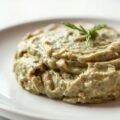Jamie Oliver’s Cauliflower Cheese Soup is a deliciously creamy, comforting dish that combines the best of two beloved foods: cauliflower and cheese. It’s basically a soup version of the classic cauliflower cheese (that cheesy, oven-baked delight) but in a smooth, velvety liquid form. The soup is made with fresh cauliflower, rich stock and a blend of sharp, creamy cheeses that melt into the soup, creating a rich, cheesy flavor with just the right amount of texture from the cauliflower.
The combination of these ingredients creates a rich, satisfying dish that feels indulgent without being too heavy. It’s ideal for cold, cozy days when you need something that not only warms you up but also feels like a comforting hug in a bowl.
Jamie Oliver Cauliflower Cheese Soup Recipe
Ingredients Needed
Making Jamie Oliver’s Cauliflower Cheese Soup is pretty straightforward. Here’s a breakdown of the essential ingredients:
- Cauliflower – The star of the show. Fresh cauliflower is best for that subtle sweetness and texture. You’ll need around 1 medium-sized cauliflower, broken into florets.
- Butter – A couple of tablespoons to sauté the onions and garlic, giving the base a rich, velvety feel.
- Olive oil – For extra depth and richness.
- Onion & Garlic – The aromatic base of the soup that adds flavor and a bit of sweetness once it’s softened.
- Vegetable or chicken stock. This is the liquid base that ties everything together. You can go with veggie stock for a vegetarian option or chicken stock for a more robust flavor.
- Cheddar cheese – This is the key to achieving the soup’s rich, cheesy character. A sharp, aged cheddar works wonders.
- Cream – To give the soup that luxurious texture and flavor. It’s optional but if you’re looking for a silky consistency, definitely go for it.
- Mustard (optional) – A tiny spoonful adds a nice kick and enhances the cheese flavor without being overpowering.
- Salt & Pepper – Just to season to taste.
- Fresh parsley (optional) – For garnish and a little pop of color.
Equipment Needed
The equipment needed is basic but here’s what you’ll need to make the process easy and efficient:
- Large pot or Dutch oven. To cook the soup. A heavy-bottomed pot works best for even cooking and heat distribution.
- Blender or hand blender (immersion blender). For blending the soup into a smooth, creamy consistency. If you don’t have an immersion blender, you can use a regular blender but be careful to let the soup cool a bit before blending in batches.
- Chopping knife and cutting board. To chop your cauliflower, onions and garlic. You don’t need to be precise, just small enough pieces to help them cook evenly.
- Measuring spoons and cups. For accurate measurements, especially for the stock, cream and seasoning.
- Cheese grater – If you buy a block of cheddar, you’ll need this to grate it, allowing it to melt quickly into the soup.
How To Make Jamie Oliver’s Cauliflower Cheese Soup
Making this soup is fairly easy and straightforward. Here’s how to do it:
- Prep the ingredients – Start by breaking your cauliflower into florets. Chop your onion and garlic finely.
- Sauté the base – In a large pot, heat up a couple of tablespoons of butter and olive oil. Once the butter is melted, add your chopped onion and garlic. Sauté them on medium heat until soft and golden, about 5-7 minutes. This step builds a flavor foundation for the soup.
- Add the cauliflower – Toss in your cauliflower florets and cook them for another 5 minutes, allowing them to soften a little and absorb the flavors from the onions and garlic.
- Add stock and simmer. Pour in your stock and bring it to a boil. Reduce the heat to low and let the mixture simmer for around 15-20 minutes or until the cauliflower is fully tender and cooked through.
- Blend the soup – Once your cauliflower is soft, it’s time to blend! You can use an immersion blender directly in the pot or transfer everything into a regular blender (just let it cool slightly to avoid splattering). Blend until smooth and creamy.
- Cheese it up – Return the soup to the pot (if you used a regular blender). Over low heat, stir in the grated cheddar cheese. The cheese will melt into the soup, creating that iconic creamy, cheesy texture.
- Season – Add salt and pepper to taste. If you like a bit of zing, mix in a teaspoon of mustard at this point.
- Finish with cream – Stir in a splash of cream to make the soup even richer and smoother.
- Serve – Ladle the soup into bowls and garnish with freshly chopped parsley, if desired. You can also add a sprinkle of cheese on top for that extra cheesy touch!
What I Learnt

One of the key takeaways from making Jamie Oliver’s Cauliflower Cheese Soup is how simple ingredients can be transformed into something incredibly comforting. The soup itself is easy to make but the blending process is a game-changer-it really transforms the cauliflower into a smooth base that feels luxurious.
The balance of flavors is subtle but satisfying. The sharp cheddar brings a nice bite without being overwhelming while the cauliflower keeps things light. I also learned that the addition of mustard, even just a little, makes the soup taste more complex and heightens the cheese flavor.
Another thing I realized is that blending the soup properly (until it’s silky smooth) really elevates the texture. If you skip this step, you’ll miss out on that perfect, creamy consistency.
Recipe Tweaks For Jamie Oliver’s Cauliflower Cheese Soup
Jamie Oliver’s cauliflower cheese soup is a warm hug in a bowl-rich, creamy and comforting. But let’s face it, tweaking a recipe to suit your taste or dietary needs is part of the fun. Here are a few ideas:
- Add More Veggies: If you want more nutrients, consider tossing in some extra vegetables. Leeks, carrots or parsnips work really well. Roast them before adding to the soup to deepen their flavors.
- Use Different Cheeses: While the traditional recipe often uses cheddar, don’t be afraid to experiment. A mix of Gruyère and Parmesan will give your soup a more complex, nutty flavor. For a stronger bite, try adding some blue cheese or smoked cheese.
- Herbs and Spices: A little sprinkle of fresh thyme or rosemary can elevate the soup. If you like heat, a dash of cayenne pepper or some chili flakes can kick things up. A splash of Dijon mustard adds a tangy edge while a squeeze of lemon at the end will give a refreshing lift.
- Vegan or Dairy-Free Options: If you’re avoiding dairy, swap the milk and cheese for plant-based alternatives like coconut milk or almond milk. Nutritional yeast can stand in for the cheesy flavor without compromising on richness. You could also use vegan cheese for the traditional melted topping.
- Texture Variations: While blending the soup smooth is classic, you can keep it a bit chunky for a heartier bite. Or for a more indulgent feel, swirl in a little double cream right before serving.
- Crunchy Toppings: For added texture, throw in some toasted breadcrumbs or crispy bacon bits on top. You can also make a garlicky crouton to serve alongside for a crunch factor that complements the soup’s creaminess.
Storage Tips For Leftovers
Leftover cauliflower cheese soup is just as comforting as the first bowl. Here’s how to store it properly and make it last:
- Cool It Down: Before putting your soup into the fridge, make sure it’s cooled to room temperature. This prevents condensation and helps it last longer. Don’t let it sit out for more than two hours, though.
- Fridge Storage: Once cooled, transfer the soup into an airtight container. It’ll last in the fridge for about 3-4 days. If you want to make it last longer, you can freeze it.
- Freezing: The soup freezes well but some of the dairy might separate when you reheat it. To freeze, portion it into individual servings for easy reheating. Just ensure you let the soup cool completely before transferring to freezer-safe containers or bags. It can stay frozen for up to 3 months.
- Reheating: When you’re ready to enjoy the leftovers, reheating on the stove over low heat works best. Stir occasionally, especially if you’ve frozen it, to help it come back together. If the texture is a little off after freezing, you can always add a splash of milk or broth to smooth it out again.
What To Eat With Jamie Oliver’s Cauliflower Cheese Soup?
This soup is rich and hearty but adding a few sides can turn it into a more well-rounded meal. Here are some ideas:
- Crusty Bread: You can’t go wrong with a slice of freshly baked sourdough or crusty baguette. It’s perfect for dipping into the cheesy soup. For a twist, try garlic bread or a savory focaccia.
- Salads: A light, fresh salad will balance the richness of the soup. A simple green salad with arugula, radishes and a lemon vinaigrette adds a nice contrast. Alternatively, a beetroot and goat cheese salad works well too.
- Roast Vegetables: Roasted vegetables, like sweet potatoes, carrots or parsnips, are another great side dish. Their caramelized sweetness complements the soup’s creaminess.
- Grilled Cheese Sandwiches: For a nostalgic twist, serve the soup with a classic grilled cheese sandwich. Try different types of bread and cheese to match the soup’s flavors. A toasted cheese and ham sandwich would also hit the spot.
- Roast Chicken: For something heartier, a roast chicken can pair beautifully with this soup. The flavors are complementary and the richness of the chicken adds an extra layer of indulgence.
FAQs
What Ingredients Do I Need For Jamie Oliver’s Cauliflower Cheese Soup?
You’ll need cauliflower, cheese (usually cheddar), onions, garlic, stock, milk, and butter. Jamie’s version also includes a bit of mustard for extra flavor!
How Long Does It Take To Make Jamie Oliver’s Cauliflower Cheese Soup?
It typically takes around 30-40 minutes, including prep and cooking time, so it’s pretty quick to whip up!
Can I Make Jamie Oliver’s Cauliflower Cheese Soup Ahead Of Time?
Absolutely! You can make it in advance and reheat. The flavors actually improve overnight.


